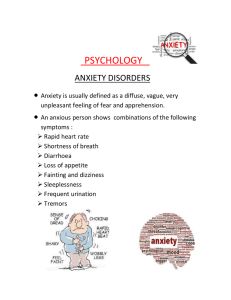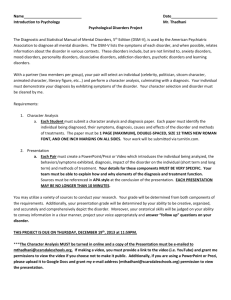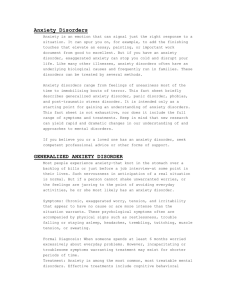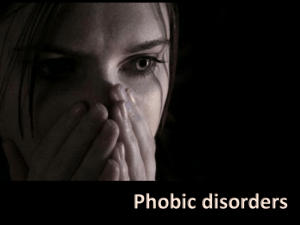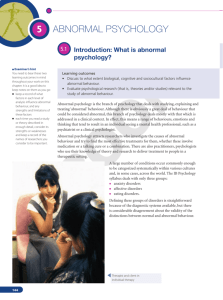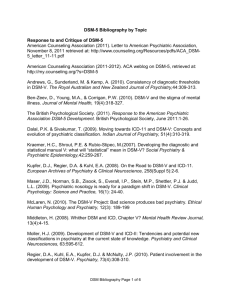Generalized Anxiety Disorder
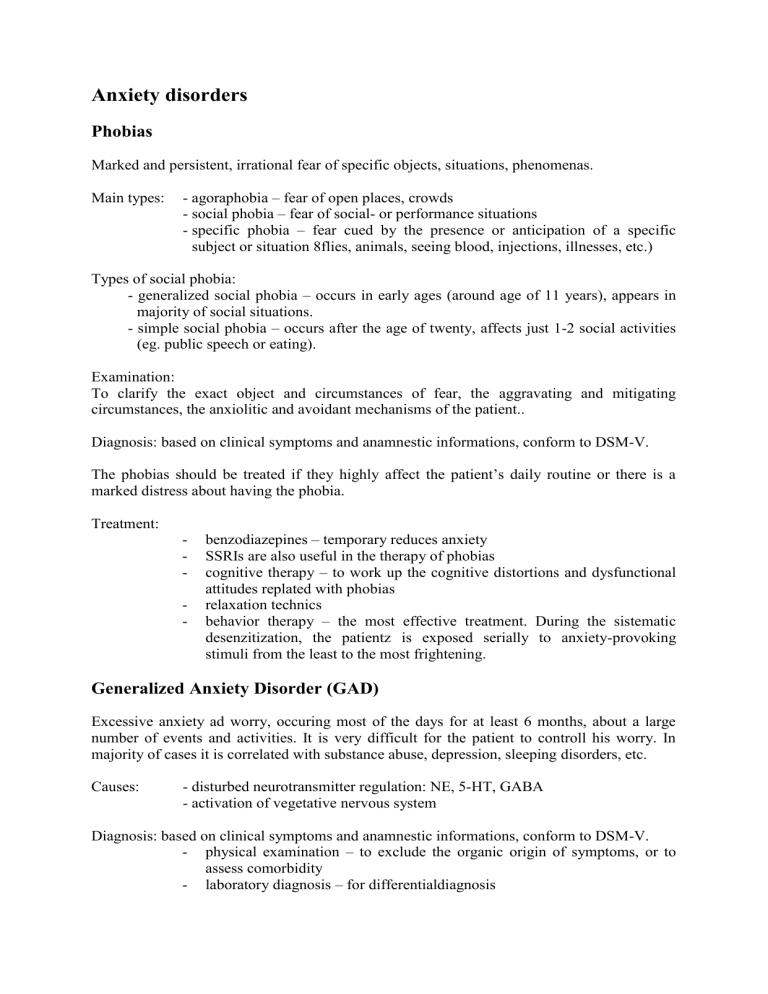
Anxiety disorders
Phobias
Marked and persistent, irrational fear of specific objects, situations, phenomenas.
Main types: - agoraphobia – fear of open places, crowds
social phobia – fear of social- or performance situations
specific phobia – fear cued by the presence or anticipation of a specific subject or situation 8flies, animals, seeing blood, injections, illnesses, etc.)
Types of social phobia:
- generalized social phobia – occurs in early ages (around age of 11 years), appears in
majority of social situations.
- simple social phobia – occurs after the age of twenty, affects just 1-2 social activities
(eg. public speech or eating).
Examination:
To clarify the exact object and circumstances of fear, the aggravating and mitigating circumstances, the anxiolitic and avoidant mechanisms of the patient..
Diagnosis: based on clinical symptoms and anamnestic informations, conform to DSM-V.
The phobias should be treated if they highly affect the patient’s daily routine or there is a marked distress about having the phobia.
Treatment:
benzodiazepines – temporary reduces anxiety
SSRIs are also useful in the therapy of phobias
cognitive therapy – to work up the cognitive distortions and dysfunctional attitudes replated with phobias
relaxation technics
behavior therapy – the most effective treatment. During the sistematic desenzitization, the patientz is exposed serially to anxiety-provoking stimuli from the least to the most frightening.
Generalized Anxiety Disorder (GAD)
Excessive anxiety ad worry, occuring most of the days for at least 6 months, about a large number of events and activities. It is very difficult for the patient to controll his worry. In majority of cases it is correlated with substance abuse, depression, sleeping disorders, etc.
Causes: - disturbed neurotransmitter regulation: NE, 5-HT, GABA
- activation of vegetative nervous system
Diagnosis: based on clinical symptoms and anamnestic informations, conform to DSM-V.
physical examination – to exclude the organic origin of symptoms, or to assess comorbidity
laboratory diagnosis – for differentialdiagnosis
psychological tests: Beck Anxiety Innventory, Hamilton Anxiety Scale, psychological status.
Differential diagnosis:
- from illnesses with similar somatical symptoms – cardiovascular dieases, endocrin disorders (hyperthyreosis, hyperkalcaemia), metabolic disorders (hypoglycaemia, hypoxia, porphiria, hyperkalaemia), neurological disorders (acathisia, epilepsia, stroke).
panic disorder
phobias
obsessive-compulsive disorder
poszttraumatic stress disorder
acut stress reaction
anxiety due to psychoactive substance
Therapy:
- psychotherapy – the most effective are the cognitive and behavior therapies, icluding psychoeducation, relaxation therapy, etc.
farmacotherapy – taking in consideration the comorbid illnesses too – antidepressants
(SSRI, SNRI), benzodiazepines, pregabalin, buspiron, hidroxizin, other substances (eg. propranolol).
Predictive factors for a bad prognosis:
- comorbid psychiatry illness
somatical comorbidity
personality disorder
poor social connections
bad relationship with family members
Obsessive-compulsive disorder (OCD)
obsessions: recurrent or persistent thoughts, impulses or images wich are intrusive, inappropriate and cause marked anxiety or distress
compulsions: repetitive behaviors that the person feels driven to perform in response to an obsession, or according to rules that must be applied rigidly. The aim of compulsions is to prevent or reduce the anxiety caused be the obsession.
Most frequent forms:
Obsessions
concern or disgust with bodily wastes, secretions, germs, toxins, etc.
fear something terrible might happen
concern or need for simmetry, order or exactness
excessive prayings or religious concerns
lucky or unlucky numbers
forbidden or perverse sexual thoughts, image sor impulses
intrusive nonsense sounds, words or music
Compulsions
excessive or ritualized hand washing, bathing or grooming
repeating rituals
checking doors, locks, etc.
cleaning and other rituals to reduce contact with contaminants
touching
ordering and arranging
measures to prevent harm to self or others
counting
hoarding and collecting
Causes: - genetical
neurobiological: the orbitofrontalis cortex, cingulum and nc. caudatus are affected
Diagnosis:
- based on clinical symptoms and anamnestic informations, conform to DSM-V.
- psychological tests: Yale-Brown Obsessive-Compulsive Scale (Y-BOCS), psychiatric anamnesis and status.
Differential diagnosis:
- other anxiety disorders
impulse control disorders
obsessive-compulsive personality disorder
depression
Therapy:
- psychotherapy: behavior therapy, psychoeducation, family therapy, relaxation, cognitive psychotherapy
farmacotherapy: SSRI, clomipramine, benzodiazepines, beta-blockers
Posttraumatic stress disorder (PTSD)
The person has been exposed to traumatic event in the past and as consequences of this trauma complains of recurrent and intrusive distressing recollections of the event, recurrent nightmares of the event, intense psychological distress at exposure cues that symbolize an aspect of the event. It is commoln an avoidance of stimuli associated with the trauma, the inability to recall an important aspect of the event and sense of foreshortened future.
Diagnosis: based on clinical symptoms and anamnestic informations, conform to DSM-V
PTSD scale, psychiatic anamnesis and status
Differential diagnosis:
- other anxiety disorders
depression
psychoactive substance induced disorder
delirium
psychotic disorder
Therapy:
- psychotherapy: cognitive and behavior therapy, psycheducation, autogenic training, family therapy, art therapy, psychodrama
farmacotherapy: antidepressants, benzodiazepines


